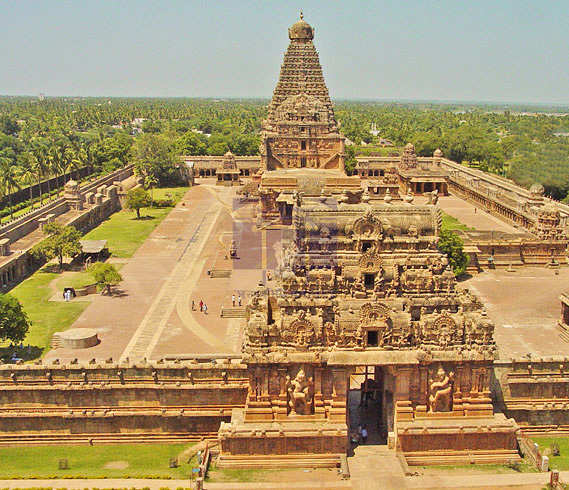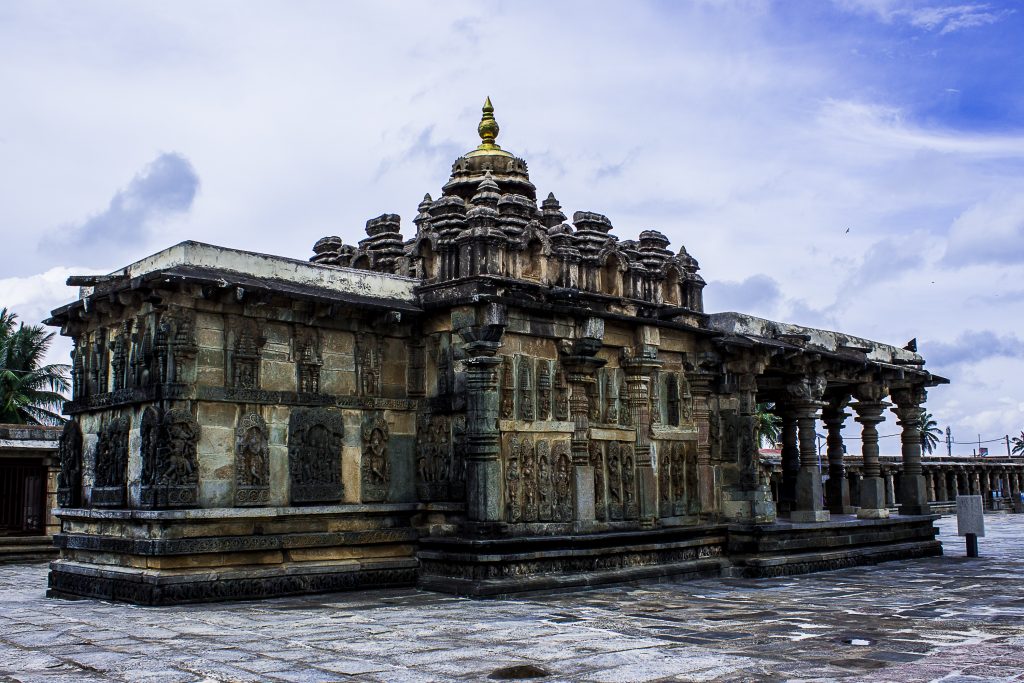1. Brihadeshwara Temple, Tanjore.
The Brihadeshwara Temple, also known as the Peruvudaiyar Kovil or RajaRajeswara Temple, is a Hindu temple located in the city of Thanjavur in the Indian state of Tamil Nadu. It was built during the reign of the Chola dynasty in the 11th century AD and is dedicated to Lord Shiva.
The temple is known for its impressive architecture and is considered to be one of the greatest achievements of the Chola dynasty. It is a UNESCO World Heritage Site and is considered to be a masterpiece of Dravidian architecture.
The temple's main attraction is its towering vimana (temple tower), which is over 200 feet tall and is made entirely of granite. The vimana is adorned with intricate carvings and sculptures that depict scenes from Hindu mythology.
Inside the temple, there is a large statue of Lord Shiva in the form of a lingam, which is believed to be one of the largest in the world. The temple also contains many other shrines and sculptures that showcase the skill and artistry of the Chola craftsmen.
Visitors to the Brihadeshwara Temple can also enjoy the temple's beautiful surroundings, which include a large park and a moat that surrounds the temple complex. The temple is a popular destination for tourists and pilgrims alike, and is considered to be one of the most important cultural landmarks in South India.

2. Kailashnath Temple, Ellora.
The Kailashnath Temple is a famous Hindu temple located in the city of Ellora in Maharashtra, India. It is dedicated to Lord Shiva and is considered to be one of the most impressive examples of rock-cut architecture in the world.
The temple was built in the 8th century AD during the reign of the Rashtrakuta dynasty, and is known for its unique design that makes it look like a freestanding temple instead of a rock-cut structure. The temple is carved out of a single piece of rock, and its intricate carvings and sculptures depict scenes from Hindu mythology.
The Kailashnath Temple is particularly famous for its large chariot-shaped shrine, which is dedicated to Lord Shiva and is surrounded by smaller shrines and sculptures. The temple's central courtyard is also surrounded by smaller shrines and sculptures that showcase the artistry and skill of the Rashtrakuta craftsmen.
The temple is a UNESCO World Heritage Site and is considered to be one of the most important cultural landmarks in India. Visitors to the Kailashnath Temple can explore its many intricacies and enjoy its beautiful surroundings, which include a large park and a lake that surrounds the temple complex. The temple is a popular destination for tourists and pilgrims alike, and is a testament to the skill and creativity of the ancient Indian craftsmen.

3. Chennakeshava Temple, Karnataka.
The Chennakeshava Temple is a Hindu temple located in the town of Belur in the state of Karnataka, India. It was built in the 12th century AD by the Hoysala dynasty and is dedicated to Lord Vishnu.
The temple is known for its intricate carvings and sculptures, which are considered to be some of the best examples of Hoysala architecture. The temple's exterior is covered in intricate carvings that depict scenes from Hindu mythology, while the interior contains many beautifully crafted sculptures and shrines.
The Chennakeshava Temple is a popular tourist destination and is considered to be one of the most important cultural landmarks in South India. Visitors to the temple can enjoy its beautiful surroundings and explore its many intricacies, including its stunning carvings and sculptures that showcase the artistry and skill of the Hoysala craftsmen.

4. Tugnath Temple, Uttarakhand
At an elevation of 3680 metres above sea level, the Tugnath Temple is the highest elevated of the Panch Kedar, the others are Madhyamaheshwar, Kedarnath, Rudranath and Kalpeshwar.The temple is connected to the Ramayana where Lord Ram meditated to release the curse of Brahmahatya for having slaughtered Ravana.The temple is quite small, and hence only 10 people are allowed in at a time.

5. Adi Kumbeswarar, Tamil Nadu
Located in the temple town of India, Kumbhakonam, this temple dates back to the Vijaynagara period.Kumbeswarar is in the form a lingam believed to have been made by Shiva himself when he mixed the nectar of immortality and sand.
6. Jagatpita Brahma Mandir, Rajasthan
7. Varadharaja Perumal Temple, Tamil Nadu
8. Konark Sun Temple, Odisha
9. Dilwara Temples near Mount Abu, Rajasthan
10. Pancha Ratna Temple, Bankura, West Bengal
Built in 1643 by King Raghunath Singha, this temple stands on a low square plinth and consists of an ambulatory pathway with a porch opened by three arches on the four sides of the temple.The walls are richly decorated with terracotta carvings featuring aspects of Lord Krishna’s life.
11. Badami Cave Temples, Karnataka
12. Vittala Temple, Hampi, Karnataka
Although the structure of this temple dates back to the 14th century, this temple is said to be 2000 years old.The temple is mainly built of marble and stone slabs.It has a distinct red pinnacle and a bird motif.The temple sanctum sanctorum holds the central images of Brahma and his second consort Gayatri.It witnesses a festival dedicated to Brahma during the Kartik Purnima.
Varadharaja Perumal Temple is a Hindu temple dedicated to Lord Vishnu located in the holy city of Kanchipuram.It is one of the Divya Desams, the 108 temples of Vishnu believed to have been visited by the 12 poet saints, or Alwars.It is believed that the lizard sculptures that adorn the ceilings of the temple when touched forgive the sins of your past life.
This temple was built by King Narasimhadeva I of the Eastern Ganga Dynasty around AD 1250.The temple is in the shape of a gigantic chariot with elaborately carved stone wheels, pillars and walls.A major part of the structure is now in ruins.The temple is a UNESCO World Heritage Site.
9. Dilwara Temples near Mount Abu, Rajasthan
Located about 2.5 km from Mount Abu, each of these five temples are unique in their own way and were built between the 11th and 13th century AD and are remarkable for their stunning use of marble.These five temples (Vimal Vasahi, Luna Vasahi, Pittalhar Temple, Parshvanatha Temple and Mahavir Swami Temple) are considered the most beautiful Jain pilgrimage sites in the world.
10. Pancha Ratna Temple, Bankura, West Bengal
Built in 1643 by King Raghunath Singha, this temple stands on a low square plinth and consists of an ambulatory pathway with a porch opened by three arches on the four sides of the temple.The walls are richly decorated with terracotta carvings featuring aspects of Lord Krishna’s life.
11. Badami Cave Temples, Karnataka
The Badami cave temples are a complex of temples located at Badami, a town in the Bagalkot District in the northern part of Karnataka, India.They are considered an example of Indian rock-cut architecture, especially Badami Chalukya Architecture.
one of the most popular of all the temples in the Hampi complex, this houses the famous musical pillars that have amazing acoustics.The British wanted to find out the reason behind this, and so they cut two pillars to check if there was anything inside that was producing the sound.
They found nothing but hollow pillars.The road leading to the temple was once a market where horses were traded.Even today we can see the ruins of the market on both the sides of the road.The temple contains images of foreigners like Persians selling horses.
13. Orchha Temples, Madhya Pradesh
Orchha is another famous tourist spot located near the famous Khajuraho Temple.The town has Chaturbhuj Temple, Lakshmi Temple and Ram Raja Temple.The Chaturbhuj temple is imposing with tall spires built atop a high platform.Its exterior is richly ornamented with lotus symbols.The Raja Ram Temple resembles a palace as the Ram is worshiped as a king here.The Lakshmi Temple is an odd mixture of temple and fort and an unique mixture of concentric forms.It consists of an octagonal central tower inside a triangular temple.In line with this eccentricity, the entrance gate is set in a corner rather than the wall.

0 Comments